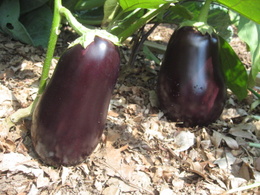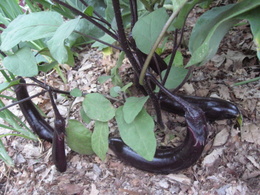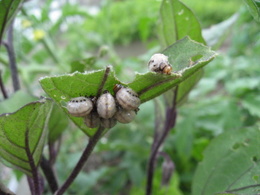Eggplant Growing Guide
Eggplant (Solanum melongena) are popular with home gardeners. Eggplants are native to Asia and require full sun, warm weather and need a long, warm growing season. They are short-lived perennial vegetables which are usually grown as annuals.
They are easy to grow and are often used in many recipes as a substitute for meat and you will find it in many Italian and Asian dishes.
There are many varieties, but the garden centers only carry a limited number of varieties, so you may want to consider to start growing your own indoors from seed.
Eggplant can range from egg size, or long and slender, to near the size of a football. Color can be deep purple, lavender, white, striped and pale green. Smaller-fruited varieties tend to produce more than the larger varieties.
Starting from Seed
Follow the seed packet instructions. In general sow the seeds indoors 6 to 8-weeks before your last expected frost date.
Sow the seeds 1/4-inch deep in a sterile seed starting mix in cell packs or pots. Lightly cover with the seed starting mix and keep moist and warm. For proper germination the seeds need to be at least 70-degrees F, but 80-degrees F is better.
Using a heat mat the seeds will germinate in about 10-days at 80-degrees F, but it may take 21-days at 70-degrees F or lower.
Bottom watering is the easiest way to keep moist without disturbing the newly sown seeds.
For more detailed information visit the seed starting page.
Soil Preparation
Eggplant will grow best in good loose organic garden soil. As soon as the soil is frost-free and can be worked, till the soil by digging down 8 to 12-inches turning the soil over with a garden fork.
Remove any large rocks and stones. Work in plenty of garden compost before planting. Eggplants do well when the soil pH is in a range of 6.3 to 6.8.
Planting
Plant eggplant in the garden in full sun after all danger of frost. It is a warm weather plant and can go into shock if the temperature should drop into the 40s.
Plant when both the air and soil temperature has warmed up. Waiting 2 to 3-weeks after your last frost date is a good time to plant and they should be spaced 24 to 30-inches apart.
Set your plant in the ground at the same depth at which they are growing in their containers. Water well to settle the soil around the plant. As the eggplant grows the weight of the fruit may cause the plant to tip over. Give them some support with a short stake or a small tomato cage to hold them up. Put up your method of support while the plant is still small so that you do not cause any root damage.
Watering and Care
When the plants are a few inches tall add a nice loose mulch of shredded leaves or pine straw to shade the plant roots. This will keep the weeds out, the soil cooler and help retain moisture. Keep the mulch a couple of inches away from the stem. During dry spells give some water each week.
Fertilizing
When the flowers appear, you can feed with a balanced organic vegetable garden fertilizer such as Espoma Garden Tone.
Harvesting Eggplant
The eggplant should be picked when they reach full-size, but not over-mature when the seeds are large. The stem is fibrous and should be cut with pruning shears leaving an inch of stem attached. It can have a slightly bitter taste if harvested when under-ripe or over-ripe. Harvest when they are glossy and firm.
A good indication of maturity is by pressing on the skin with your thumb. If it is very hard and you cannot make a dent then it is not ripe. If you press and you make a dent that springs back then it is ripe and ready to pick. If you press and you make a dent that does not spring back then it is over-ripe.
When cut, the seeds should be small and soft. If you do not see any seeds it is under-ripe and if the seeds are hard and dark the eggplant is over-ripe. With a little bit of experience you will learn when to pick them.
Popular Varieties
Early varieties: Easter Egg, Ichiban, Dusky, Hansel, Little Fingers, Orient Express.
Mid-season varieties: Beatrice, Black Beauty, Classic, Fairytale, Ghostbuster, Neon.
Sources: Seeds Now, Burpee, Park Seed
Diseases and Pests
Occasionally found on eggplant, but very destructive is the Colorado potato beetle (Leptinotarsa decemlineata) and the false potato beetle (Leptinotarsa juncta.)
In the larval stage the Colorado potato beetle is reddish-orange and has two rows of black dots along each side, while the similar false potato beetle is white to light gray with a single row of black dots along each side. The false potato beetle usually eats leaves of weeds such as horse nettle and other plants in the nightshade family.
Hand picking them is the best method of control. Use tweezers and drop them into a container of soapy water. Carefully inspect the underside of the leaves for the eggs. The entire leaf can be removed or the portion with the eggs can be cut off. Destroy the larva and eggs, do not put in the compost pile.
The adult Colorado potato beetle is orange-yellow with ten black stripes on the wing covers. The adult false potato beetle looks similar but the center strips on the wing covers is brown.
Aphids, spider mites, downy and powdery mildew can occur in humid climates.
Tomato hornworm and tobacco hornworm are occasionally found eating on the leaves. The best method of control is hand picking them.
Tips and Warnings
Do not plant your eggplant in the same place 2-years in a row. Mulch after planting with shredded leaves or pine straw. Keep the soil moist and water weekly during dry spells.
At the end of the season put the dead plants in the trash, not the compost pile.
Garden Spikes newsletters give you timely information once or twice a month. Subscribe Free to the Garden Times newsletter below.
Your email address will only be used to send you a newsletter and will never be sold. You can unsubscribe at any time.



